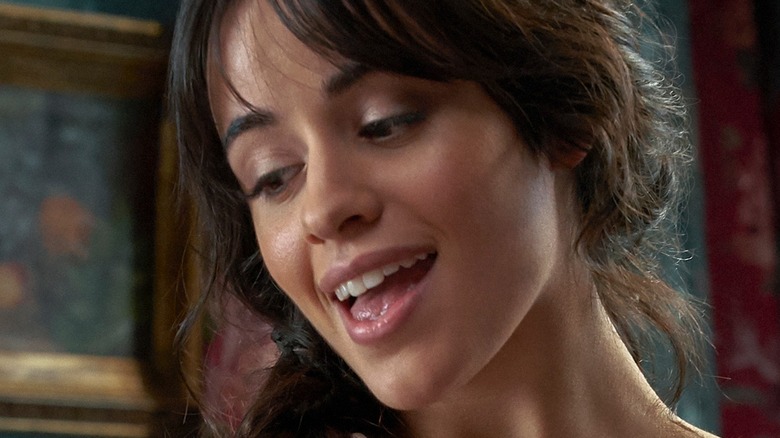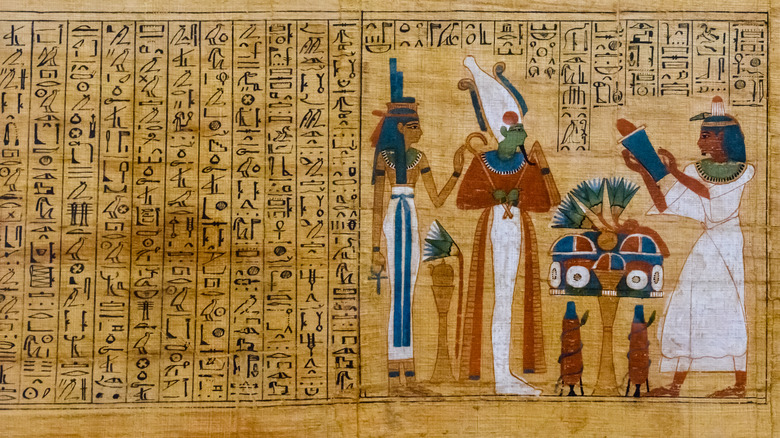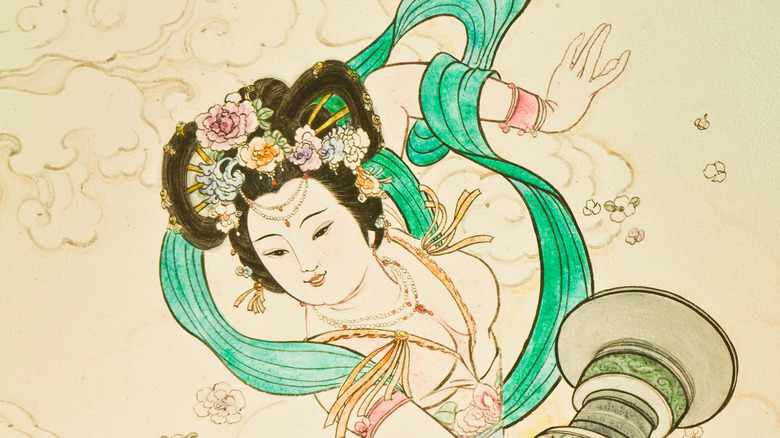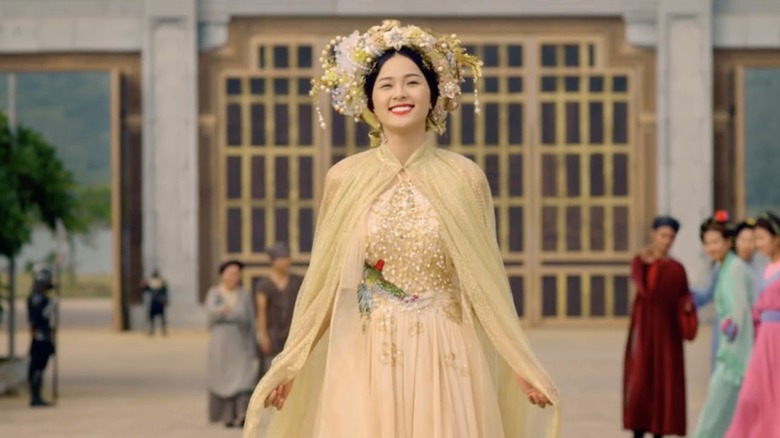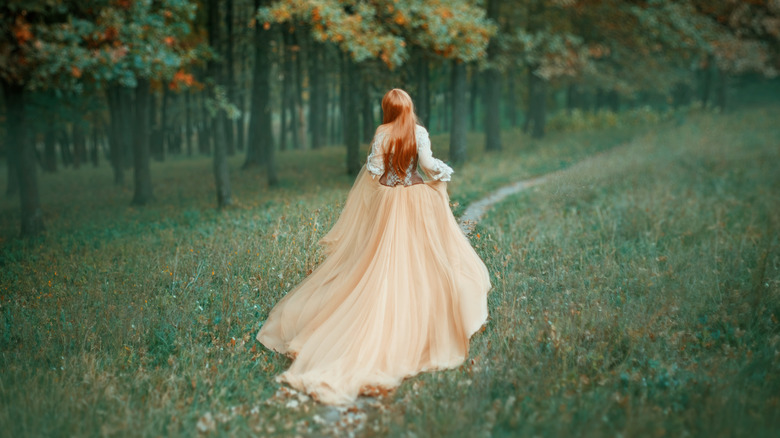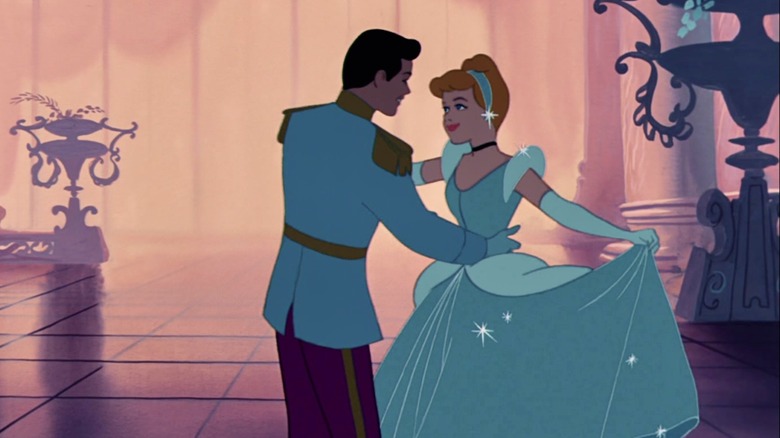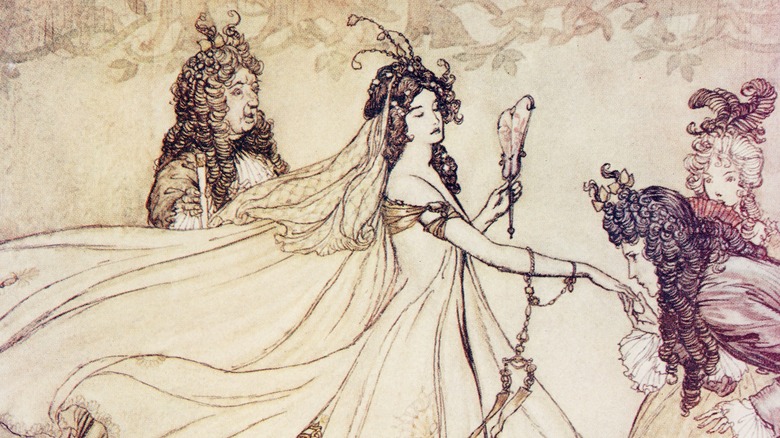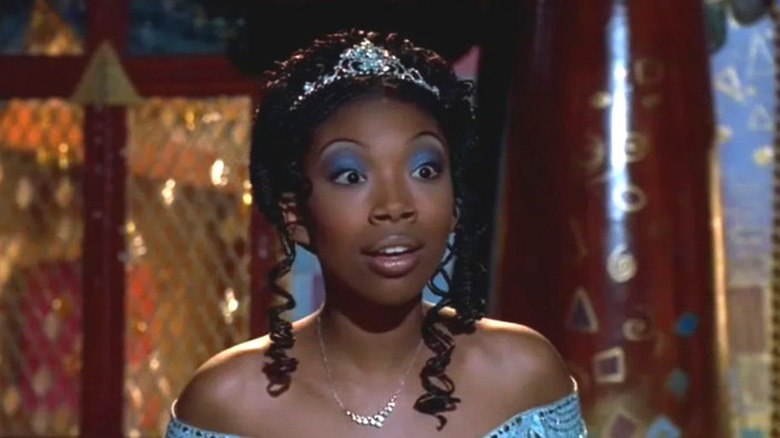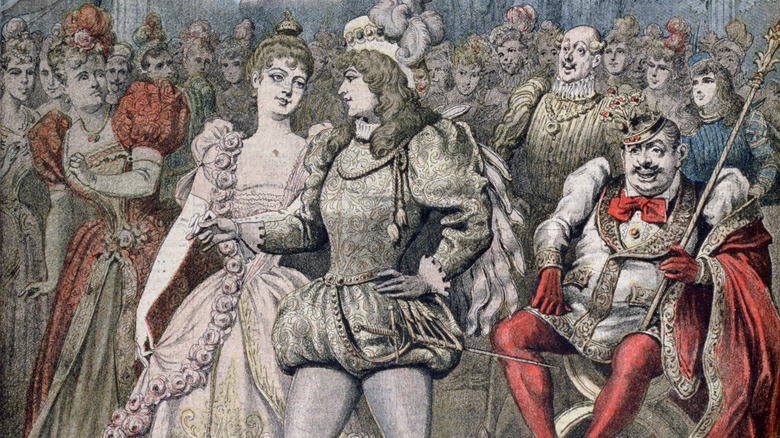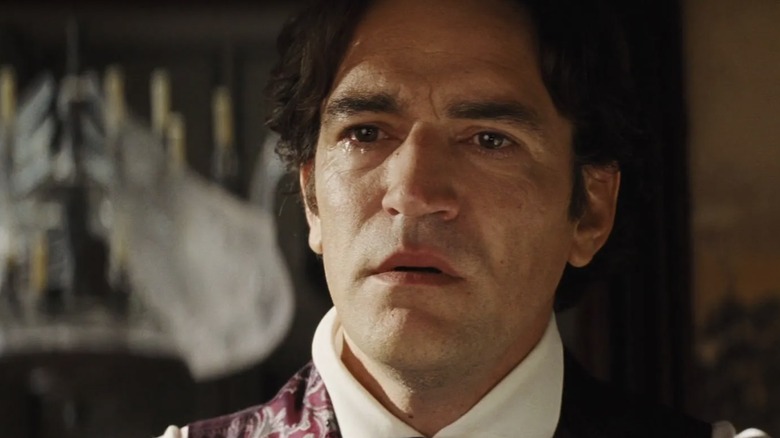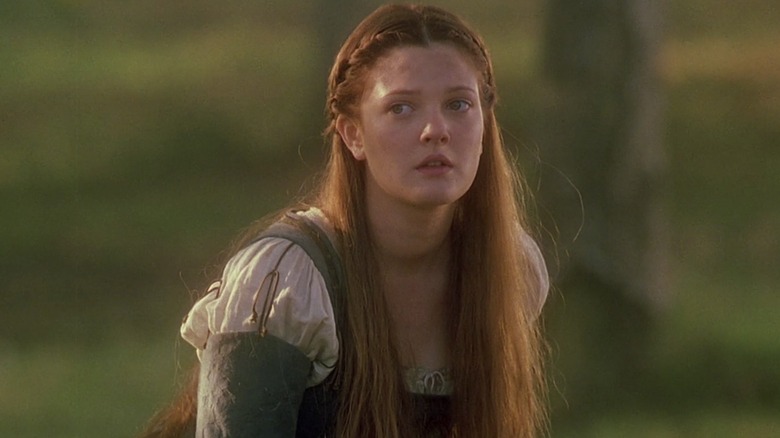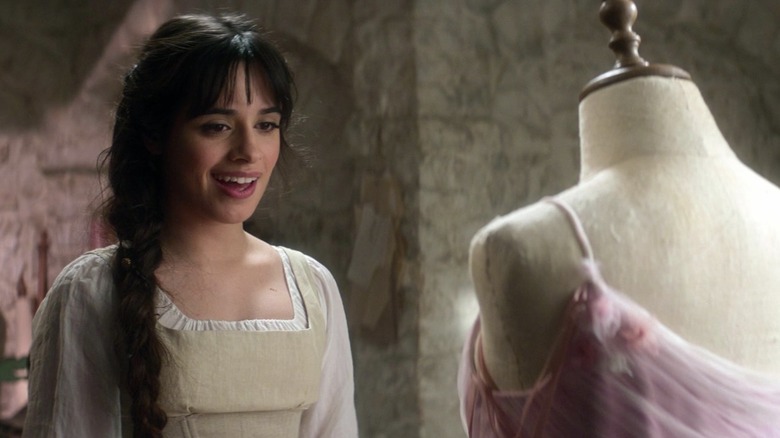The Dark History Of Cinderella
The term "Cinderella story" has become an American idiomatic expression synonymous with rags-to-riches (per Time). These stories are often about a young woman persecuted by those who should love and care for her. She survives their abuse with her optimism intact, and is rewarded for her kindness with an advantageous royal marriage.
The "Cinderella" fairy tale is ancient, archetypal, and always about classism. It has been retold hundreds of times, and interestingly enough, Disney's animated version saved the entertainment giant from foreclosure in 1950. The version of "Cinderella" we are most familiar with in the West comes from this Disney animated feature. It is a happily-ever-after tale about a worthy woman finding a place on easy street.
There are other versions, from different cultures all over the world, that have far darker origins. Some versions of these Cinderella-like stories are mere sketches of a miserable existence, while others are quite imaginative, violent, bloody, and twisted. Join us as we explore the dark history of "Cinderella."
The earliest Cinderella-like story comes from the Hellenistic period
The oldest Cinderella story is more accurately, Cinderella-adjacent. The Greek writer Strabo recorded the tale of Rhodopis in "Geographika" between 7 B.C.-24 B.C. Rhodopis was a slave and a Greek courtesan. She was purchased by Xanthes, who brought her to Egypt, where he set her free. Rhodopis was said to have known the poetess Sappho and Aesop, before she was taken to Egypt, suggesting she ran in an interesting circle and was a real historical figure (per Tales of Forgotten Times).
One day while Rhodopis was bathing, an eagle stole one of her sandals, flying to Memphis, where the eagle dropped the sandal in the lap of the Pharaoh, Amasis II (ruled 570-526 B.C.). The beautiful sandal, and how it came into his possession, fascinated the Pharaoh, so he sent his men throughout his land to find the woman who wore the sandal. She was brought to Memphis to marry the Pharaoh after they found her in Naucratis (per World History).
Rhodopis had already attained wealth and social status all on her own before she met and married the Pharaoh. Still, starting life as a slave, and later becoming the Pharaoh's wife, is the definition of a rags-to-riches story. There are obvious differences between this story and the "Cinderella" tales we are familiar with in the West. Per Tales of Forgotten Times, classical scholar William F. Hansen categorizes Rhodopis' Cinderella-like tale into the "Eastern" tradition, where our protagonist only meets her prince, or Pharaoh in this case, after he finds her shoe.
A Cinderella story from Ancient China has almost all the story beats we know
"Ye Xian," also known as "Yeh-Shen," was written by Tuan Ch'êng-shih and was published between 856-860 A.D. in "Miscellany of Forgotten Lore" during the Tang dynasty (per JSTOR). It is the oldest published version that hits most of the story beats we know today. It has a beautiful and sweet orphan, a wicked stepmother and half-sister who persecutes her, magic, and a lost shoe that leads to a royal wedding (per Vox).
Rather than mice, our heroine has a fish for a friend, and this element is common in most Asian versions. Her stepmother kills the fish, cooks it, and eats it with her stepsister. Ye Xian is heartbroken, and her cries draw the attention of a bearded monk who tells her where the bones are buried so she can dig them up. He tells Ye Xian if she prays over the fish bones, her prayers will be granted. When Ye Xian wants to attend a festival, her stepmother forbids it. Ye Xian prays for an outfit to wear, and defies her stepmother.
She attends, and people praise her beauty and grace. Her half-sister recognizes her and Ye Xian flees, leaving behind a beautiful gold slipper. This slipper finds its way to the king, and he sends his men searching for the woman who fits the shoe so he can marry her. In one version, Ye Xian forgives her stepmother, while in another version, stones crushed the stepmother and sister.
There are other Cinderella stories from Asia
There are other Cinderella stories from Asia. The Vietnamese tale "The Story of Tam and Cam" is among the most detailed and gruesome. The story includes murder, reincarnation, suicide, and, in some older versions, cannibalism. This Vietnamese Cinderella story is unique, because it doesn't end with Tam, our kind and beautiful heroine, marrying the king. The story continues after their marriage.
Tam's stepmother and half-sister Cam won't leave Tam alone after she marries the king. The wicked stepmother kills Tam when she visits on her father's anniversary day. Tam's love for the king brings her spirit back, first in the guise of a bird Cam kills, and then as a piece of fruit that transforms into the beautiful girl she once was. Once Tam and the king are reunited, she gets her revenge after Cam boils herself to death wishing she was beautiful like Tam. In some versions of the story after Cam's suicide, Tam feeds her half-sister Cam to her stepmother in a sick plot twist.
This is Vietnam's most famous fairy tale, and it's taught in schools. Reportedly, the elements of cannibalism were removed from official textbooks in 2011. In 2016, the Vietnamese language film "Tam and Cam: The Untold" was released. This visually gorgeous adaptation expands the story, adding political intrigue at the royal court, but is otherwise faithful to the Vietnamese fairy tale. It is certainly one of the darkest iterations of "Cinderella" we have seen.
If you or anyone you know is having suicidal thoughts, please call the National Suicide Prevention Lifeline by dialing 988 or by calling 1-800-273-TALK (8255).
The first published European version of a Cinderella story was Basile's The Cat Cinderella
Giambattista Basile's "The Cat Cinderella" was published in a collection of tales, "The Pentamerone," in Italy in 1634 after Basile's death. In this dark version, our protagonist is named Zezolla, and she is the daughter of a prince. After her mother dies, her father takes a second wife who is unkind to Zezolla. Zezolla has a loving governess, whom Zezolla wishes were her stepmother. The governess convinces Zezolla to kill her stepmother by breaking her neck with the lid of a storage trunk.
After the governess marries Zezolla's father, our protagonist experiences a fall from grace and is mistreated by her six stepsisters. Fairies from Sardinia send her a magical fig tree that grows in a matter of days, providing her with beautiful clothing to wear for a series of banquets where she meets the king. Zezolla leaves the banquets early, trying to evade the servant who is supposed to follow her home. She loses a shoe and ends up married to the king, but we never get the sense that Zezolla wanted to marry the king.
It seems like Zezolla only attended the banquets to draw attention away from her awful sisters, and she had no genuine interest in the king. As Kelsey McKinney with Vox suggests, this was a forced marriage, and Zezolla went to great lengths to evade the king's attention. Considering she murdered her first stepmother, maybe she didn't deserve a happy ending.
French writer Charles Perrault published the version we are familiar with today
Disney's 1950 animated film is an adaptation of Charles Perrault's 1697 "Cendrillon," or "The Little Glass Slipper." Perrault is recognized as the writer who created the "Cinderella" version we are familiar with in the West, according to Vox. The largest distinction between Perrault's and Disney's stories comes down to one sentence: "The poor girl bore it all patiently, and dared not tell her father, who would have scolded her; for his wife governed him entirely."
Yep, you read that right. Cinderella's father didn't die in this version of the story. He simply ignored how badly she was treated by his new wife, and her wretched daughters. This is the dark tragedy in Perrault's tale. Her father was indifferent to her misery. Another distinction between the two stories is Cinderella doesn't attempt to attend the ball with her sisters in Perrault's version, as she does in the cartoon. Perrault is credited with adding the fairy godmother, the glass slipper, and the happy ending to the story (per Book Riot).
In Perrault's story, Cinderella attends two balls, while Disney only had time for one. It was at the second ball Cinderella lost her slipper in Perrault's version, and this glass slipper led to her royal marriage and happy ending. Unlike Disney's version, the only animals in Perrault's fairy tale were transformed into carriage drivers and footmen, suggesting the talking animals in Disney's animated feature are drawn from another source, or are simply part of the Disney brand.
The Brothers Grimm published their version of the story in 1812
The Brothers Grimm published their first edition of "Cinderella" in 1812, but continued changing all their stories until 1864 (per Vox). The Grimm version is similar to Giambattista Basile's "The Cat Cinderella," but Cinderella doesn't murder her stepmother in either Grimm version of "Cinderella." Like Basile's story, it involves a magical wishing tree, and birds who assist Cinderella with menial tasks.
The 1812 version of "Cinderella" has no fairy godmother to transform animals into footmen, and pumpkins into magical coaches, but it does have a curfew of midnight when the magic wears off and three balls, two of which Cinderella attends. This version also explains why the horrible stepsisters, who are beautiful but cruel, call our heroine "Cinderella." She doesn't have a bedroom, and sleeps at the foot of the fire where the ashes soil her beautiful face.
The 1857 version of "Cinderella" gives us no curfew, but a more assertive Cinderella simply leaves the ball because she wants to. This version also makes the prince seem controlling. He doesn't allow her to dance with anyone else, and insists on escorting her home, so she runs away from him each night hoping he won't discover where she lives. On the third night, she loses a shoe, and the prince uses the slipper to verify her identity.
This version also includes gruesome mutilations where the step-sisters cut off toes and heels trying to fit into the golden shoe, and birds peck their eyes out at the royal wedding. Disney may have borrowed the helpful animals from the Brothers Grimm version of "Cinderella," but we can see why they left out the mutilation.
There are Russian versions
In one Russian version of "Cinderella," "The Baba Yaga" by Aleksandr Afanasyev, our protagonist has a stepmother who beats her and concocts plans to kill her, sending her into the woods to be eaten by Baba Yaga, a morally ambiguous witch in Russian folklore. The girl escapes by keeping her wits, and with the help of animals whose loyalty she earns through kindness. Once the girl arrives home and tells her father what happened, he shoots his wife for abusing his daughter.
"Vasilissa the Beautiful" is called "Vasalisa the Wise" in Clarissa Pinkola Estés' foundational book, where she studies the wild woman archetype in folktales. Vasilissa's tale is an obvious Cinderella story about a merchant and his daughter, her wicked stepmother who beats her, and two stepsisters. Before Vasilissa's mother dies, she gives her daughter a doll to advise and help in the mother's absence. Rather than a kind fairy godmother, Vasilissa is helped by her doll, and a frightening witch named Baba Yaga who lives deep in the forest and threatens to eat her.
Much like the Grimms' "Cinderella," this Russian version of the story includes Vasilissa getting help with tedious menial tasks, like sorting grain and housework, but ends happily with Vasilissa marrying the tsar because of her beauty, skill, and intelligence. In a brutally dark twist, Vasilissa burns her stepmother and stepsisters to death with the fire Baba Yaga provided. These Russian versions of the folktale are certainly too disturbing for Disney, but reflect the darker origins of some Cinderella stories.
There are hundreds of Cinderella stories
According to the American Library Association, there are over 500 Cinderella stories just from Europe alone! Occasionally, the Cinderella character is even a persecuted man. Considering Cinderella-like stories were told and retold for at least 2,000 years, they come from every continent and culture imaginable. According to NPR, a book written in 1893 by Marian Roalfe Cox explored, "three hundred and forty-five variants of Cinderella, Catskin, and Cap o'Rushes" folktales. Considering that was over 200 years ago, it isn't surprising there are more variants today.
The ATU (Aarne-Thompson-Uther) index, which was created by Antti Aarne, a Finnish folklorist in 1910, and most recently updated in 2004 by a German folklorist named Hans-Jörg Uther, categorizes fairy and folktales from multiple languages and cultures based upon their plot, themes, and motifs (per Book Riot). Some stories even involve heroines who are born inside squash and were abandoned by their mothers, before being found by a prince who abuses them until their beauty dazzles him at a ball, and they fall in love (per NPR).
Stories that are "Cinderella"-like are categorized as a 510 group with two sub-groupings. 510A stories are about persecuted heroines who are saved from their cruel families by advantageous royal marriages, while 510B stories center on an "unnatural love."
Some Cinderella-like stories feature a father who wants to marry his daughter
Some stories about a persecuted young woman who goes from rags to riches feature a beautiful daughter who runs away because her father wants to marry her. Yep, you guessed correctly, these are the ATU 510B grouping. These folktales leave little question as to why no modern filmmakers have attempted to make adaptations. There just isn't much demand for stories about men who want to marry their beautiful daughters these days.
The number of tales from this grouping certainly makes you wonder how prevalent this behavior was in the past. The German tale "Cinder Blower" is about a beautiful and cunning girl who escapes her father. Disguised as a boy, she takes work in a palace kitchen as a cinder blower. She uses the magic wand and beautiful dresses her father gave to her, hoping to gain her hand in marriage, to dazzle the prince at a series of balls. He discovers his love is the cinder blower because she has a ring he gave her. After discovering her identity, they marry and live happily ever after.
In these 510B tales, our heroine doesn't have a wicked stepmother to contend with, but an overly amorous father. Unlike the heroines from the 510A stories, like Perrault's "Cinderella," the heroines in these 510B tales use their wits to escape their fathers, and secure their marriages through their own efforts. These heroines have more gumption and agency than many of our sweet Cinderellas. The dark taboo they are running away from is a powerful motivator.
In many versions of Cinderella, her father is not dead
Although Cinderella's father is dead in the Disney animated movie, and in other modern adaptations we've discussed, in many other versions of the story, her father is still alive. He is indifferent or unaware of Cinderella's persecution, and sometimes he even takes part. In Charles Perrault's "The Little Glass Slipper," which is the version Disney cites as its source, Cinderella's father is still alive.
In the Grimm Brothers' first edition, the father was never mentioned again after he marries a second wife who is cruel to Cinderella. But, in the Grimm 1857 version of "Cinderella," when the prince asks if another daughter is living in their household to try on the slipper, Cinderella's father says, "There is only a deformed little Cinderella from my first wife, but she cannot possibly be the bride."
It isn't just European Cinderella stories that depict Cinderella's father in a poor light. In "Maria and the Golden Slipper" from the Philippines, Maria's father is still alive and allows his second wife and stepdaughters to torment Maria. This is also true of Vietnam's "The Story of Tam and Cam." Tam's father allows his second wife to banish Tam to the kitchen, working as a servant before he dies. It seems only modern film interpretations depict Cinderella as an orphan. In the Russian "The Baba Yaga" and "Vasilissa the Beautiful," our heroine's father is away on business when his wife tries to kill Vasilissa.
Cinderella is about the intersection of classism and sexism
Cinderella stories are about classism and sexism. They explore the lengths stepmothers go to ensure their financial stability by exploring how biological children were seen as a threat to second wives. Cinderella stories are an exploration of how, for centuries, women could only hope to better their circumstances through a beneficial marriage.
Disney's animated "Cinderella" has been accused of reinforcing marriage as the central concern of a young woman. "Cinderella" was a product of its time, coming out in 1950, at the start of a decade that embraced the nuclear family, marrying young, and achieving financial success. Cinderella's rags-to-riches story is the American dream (per Refinery 29). What critics don't acknowledge is that these folktales acknowledged women's bleak reality; sometimes that's as subversive as a story can be in a patriarchal society.
Director Kenneth Branagh's gorgeous live-action remake of "Cinderella" doesn't update the story by making it more feminist. The major difference from the cartoon is that Ella (Lily James) meets the prince, Kit (Richard Madden), while horseback riding in the woods, making a connection before she learns he is a prince, thus proving theirs is a love match.
They borrowed this plot divergence from "Ever After," the most feminist Cinderella movie. "Ever After" exposes Dannielle's (Drew Barrymore) limited options with an unflinching eye. She is a bright, passionate, kind social justice warrior, but she is also an orphan. She is a woman in a culture where women don't have power or choices. Luckily, Dannielle inspires Prince Henry (Dougray Scott), giving her a chance to effect a change in the world as his wife.
Not all Cinderella stories have a happy ending
Amazon's live-action "Cinderella" might be the most upbeat and ethnically diverse adaptation since the TV movie starring Brandy. In Amazon's "Cinderella," Ella's (Camila Cabello) wicked stepmother (Idina Menzel) isn't all that wicked, and the musical numbers are pop-cover confections. Our heroine, Ella, has ambitions beyond marriage, and chooses a career as a dressmaker over marrying Prince Robert (Nicholas Galitzine). This film depicts a new generation of Cinderella stories, with a heroine who is confident and assertive.
Although seeing Billy Porter as the Fabulous Godmother was amazing, and the effort to make this story empowering for little girls was appreciated, this adaptation just doesn't have the emotional resonance of earlier interpretations. Frankly, the misery is missing, and happy endings just don't have the same power if our heroine's rags-to-riches story doesn't have enough contrast. You can't truly appreciate joy without having sorrow to compare it to, and Ella just doesn't seem miserable.
Although we have come to expect Cinderella to have a happy ending, not all traditional Cinderella folktales end with a fortunate marriage. Some keep with the old tradition of ending unhappily. The Native American folktale "The Turkey Herd" ends with the heroine's turkeys abandoning her because she stayed too long at the dance. The Danish story "The Two Princesses" ends with our heroine, the youngest princess, working as a kitchen servant for the rest of her life because she stayed at the ball after curfew, and her dress turned to rags. Both tales dole out punishment instead of a happy ending when our heroines forgot their responsibilities, and stayed out past their curfew.
